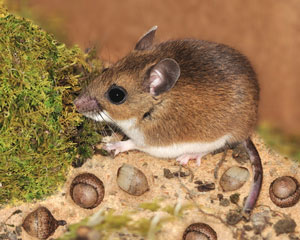Are Deer Mice More Common Than House Mice?
By Chris Williams on April 11, 2013.
 Question
Question
How can you tell the difference between a house mouse and a deer mouse? I just caught a couple of mice in our garage that looked different. When I googled them, the description sounded more like deer mice. I thought deer mice lived in the woods or something.
Answer
It certainly could have been deer mice in your garage. The most obvious difference between the two mice is in coloration. Deer mice, Peromyscus maniculatus, tend to be sort of “deer-colored,” a tawny brown which can tend towards gray, while house mice are mostly gray. Besides the basic color though, deer mice, like deer, are white below. They have a white belly, white legs and feet, and the underside of their tail is also white. House mice have no such two-toned color. The other differences are easier to see if you have the two mice side-by-side. Deer mice have larger ears and larger eyes than house mice, they have a hairier tail, and they are slightly larger. The two mice have similar habits.
The Other Deer Mouse
There is a second mouse, Peromyscus leucopus, the white-footed mouse, that looks almost identical to the deer mouse and is actually more common in the eastern U.S. The term deer mouse is used by most people for either mouse. The white-footed mouse is the mouse most often implicated in the spread of Lyme disease from ticks.
It’s true that we think of deer mice as mostly outdoor mice while house mice are the ones we expect to find in our homes. Complaints of deer mice used to be limited to cabins, or rural or semi-rural homes. That seems to have changed somewhat. Deer mice commonly get into homes now, especially in the fall. In fact, in a recent national poll of pest control companies, 28% said they were seeing an increase in outdoor rodents like deer mice and wood rats in buildings. One New England company commented that the deer mouse has become its main rodent pest indoors.
Deer Mouse Nests
The deer mouse is the most widely distributed outdoor mammal in North America. Outdoors, it nests around the roots of trees, under boards or logs, in tree stumps, sheds, garages, abandoned vehicles, farm equipment, wood piles, or in squirrel or bird nests. Outside, it feeds mainly on seeds and nuts. Inside, deer mice nest in most of the same hidden areas as house mice. Their nests can be over a foot in diameter and are lined with shredded paper, insulation, or cloth. They often carry in seeds and nuts and store them in hidden places like wall voids or dresser drawers. Sometimes this hoarded food becomes infested with food pests like Indian meal moths or grain beetles.
One concern with deer mice (and sometimes white-footed mice) is the risk of hantavirus. The disease is spread when people inhale airborne dust particles that are contaminated with mouse urine, droppings, or saliva. Hantavirus is rare in the eastern U.S. and is a problem mainly where deer mice have nested in large numbers or for a long time and the accumulated droppings are disturbed.
Like house mice, deer mice can be controlled with either baited traps or rodenticides. Because these mice are associated with both Lyme disease and hantavirus, as well as some less common diseases, you should probably call a pest control professional. At Colonial, we’re very familiar with deer mice and our work is guaranteed. We are also experts at rodent-proofing, sealing up all those little openings that mice use to get inside. Give us a call today.